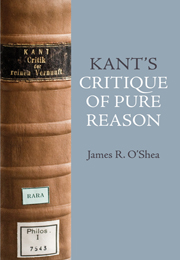Book contents
- Frontmatter
- Contents
- Preface
- INTRODUCTION
- 1 METAPHYSICS AND THE “FIERY TEST OF CRITIQUE”
- 2 WAKING FROM DOGMATIC SLUMBERS: HUME AND THE ANTINOMIES
- 3 SPACE AND TIME AS FORMS OF HUMAN SENSIBILITY
- 4 THE CATEGORIES OF UNDERSTANDING AND THE THINKING SELF
- 5 ONE LAWFUL NATURE
- 6 CONCLUSION: PURE REASON'S ROLE IN KANT'S METAPHYSICS OF NATURE
- Bibliography
- Index
3 - SPACE AND TIME AS FORMS OF HUMAN SENSIBILITY
- Frontmatter
- Contents
- Preface
- INTRODUCTION
- 1 METAPHYSICS AND THE “FIERY TEST OF CRITIQUE”
- 2 WAKING FROM DOGMATIC SLUMBERS: HUME AND THE ANTINOMIES
- 3 SPACE AND TIME AS FORMS OF HUMAN SENSIBILITY
- 4 THE CATEGORIES OF UNDERSTANDING AND THE THINKING SELF
- 5 ONE LAWFUL NATURE
- 6 CONCLUSION: PURE REASON'S ROLE IN KANT'S METAPHYSICS OF NATURE
- Bibliography
- Index
Summary
We can accordingly speak of space, extended beings, and so on, only from the human standpoint. If we depart from the subjective condition under which alone we can acquire outer intuition, namely that through which we may be affected by objects, then the representation of space signifies nothing at all. This predicate is attributed to things only insofar as they appear to us, i.e., are objects of sensibility.
(Kant, Critique of Pure Reason, A26–7/B42–3)Kant pulls no punches in the passage above. Certainly outside philosophy – for that matter, even inside philosophy – it must strike us as counter-intuitive to assert that spatial properties such as size, shape, location and distance are correctly attributed to, and hence possessed by, material bodies “only from the human standpoint”. For when we human beings speak truly about or mathematically represent the fact, for example, that a certain planet's average distance from the sun is approximately 5,869,660,000 kilometres, what is thereby represented is a fact about the spatial layout and temporal history of the material universe. And that is a fact that obtained long before any human beings intruded on the scene. Kant's ‘transcendental idealism and empirical realism’, as we saw in Chapters 1 and 2, is supposed to be compatible with any and all such empirical discoveries about the vast and limitless ‘age and size’ of the material universe in space and time.
- Type
- Chapter
- Information
- Kant's Critique of Pure ReasonAn Introduction and Interpretation, pp. 78 - 115Publisher: Acumen PublishingPrint publication year: 2011

